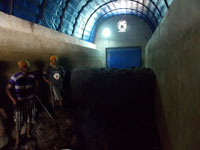 Mushroom Compost is Often referred to as Spent Mushroom Substrate (SMS), Mushroom Compost is the growing medium that results from the mushroom growing process. Mushroom Compost is made from agricultural materials, such as hay, straw, Sunflower deoil cake(DOC), poultry litter, cottonseed husk and gypsum. Sphagnum peat moss adds to the organic nature of the substrate, providing a consistent, formulated and homogeneous product.
Mushroom Compost is Often referred to as Spent Mushroom Substrate (SMS), Mushroom Compost is the growing medium that results from the mushroom growing process. Mushroom Compost is made from agricultural materials, such as hay, straw, Sunflower deoil cake(DOC), poultry litter, cottonseed husk and gypsum. Sphagnum peat moss adds to the organic nature of the substrate, providing a consistent, formulated and homogeneous product.
After mushrooms are harvested, the Mushroom Compost is steam treated prior to removal to eliminate any pest, pathogens and weed seeds resulting in a fertilizer product.
Mushroom Compost has high water and nutrient holding capacity and exhibits no nitrogen draw down problems.
As a fertilizer and soil amendment for farming, Mushroom Compost supports plant growth in a variety of plant applications such as corn, pumpkin, tomato, carrot and potato yields.
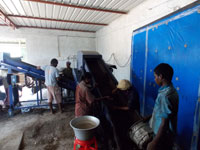 Mushroom Compost supports plant growth of much hays from orchard grass, timothy, reed canary grass, tall fescue and brome grass.
Mushroom Compost supports plant growth of much hays from orchard grass, timothy, reed canary grass, tall fescue and brome grass.
As a fertilizer and soil amendment for lawn care and landscaping, Mushroom Compost supports plant growth and inhibits artillery fungus.
In general, a good, organic compost, if used properly, can improve plant growth in poor or marginal soils. This is because compost amended into those soils will improve the structure of clay soils, reduce surface crusting and compaction and therefore improve drainage, increase beneficial soil microbial activity, and provide nutrients to plants which can reduce the need for fertilizer. Overall, compost can be very beneficial to the soil, and mushroom compost is no exception.
What beneficial properties are found in mushroom compost?
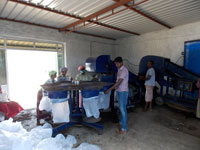 The visual appearance of a good quality, thoroughly processed mushroom compost typically resembles a dark topsoil, has a loose crumbly structure, and has an “earthy” aroma. Recent research conducted at the Pennsylvania State University showed that mushroom compost contains an average of 25 percent organic matter and 58 percent moisture on a wet volume basis. Where uniform application and good mixing with soil is required, this amount of organic matter and moisture in mushroom compost is ideal for handling and making surface applications or incorporating into the soil. Mushroom compost contains an average of 1.12 percent nitrogen in a mostly organic form that slowly is available to plants. Also, mushroom compost contains an average of 0.67 percent phosphate (phosphorous) and 1.24 percent potash (potassium), as well as other plant nutrients such as calcium (2.29 percent) magnesium (0.35 percent) and iron (1.07 percent). The average pH of mushroom compost is 6.6 (6.0 to 7.0 is an ideal range for most plants). The amount of carbon relative to nitrogen is an important indicator of nitrogen availability for plant growth, and an ideal compost should have a ratio of 30:1 or lower. Mushroom compost has an excellent 13:1 ratio, indicating outstanding nutrient availability and mature and stable organic compost.
The visual appearance of a good quality, thoroughly processed mushroom compost typically resembles a dark topsoil, has a loose crumbly structure, and has an “earthy” aroma. Recent research conducted at the Pennsylvania State University showed that mushroom compost contains an average of 25 percent organic matter and 58 percent moisture on a wet volume basis. Where uniform application and good mixing with soil is required, this amount of organic matter and moisture in mushroom compost is ideal for handling and making surface applications or incorporating into the soil. Mushroom compost contains an average of 1.12 percent nitrogen in a mostly organic form that slowly is available to plants. Also, mushroom compost contains an average of 0.67 percent phosphate (phosphorous) and 1.24 percent potash (potassium), as well as other plant nutrients such as calcium (2.29 percent) magnesium (0.35 percent) and iron (1.07 percent). The average pH of mushroom compost is 6.6 (6.0 to 7.0 is an ideal range for most plants). The amount of carbon relative to nitrogen is an important indicator of nitrogen availability for plant growth, and an ideal compost should have a ratio of 30:1 or lower. Mushroom compost has an excellent 13:1 ratio, indicating outstanding nutrient availability and mature and stable organic compost.
How much mushroom compost should be used for establishing roadside vegetation?
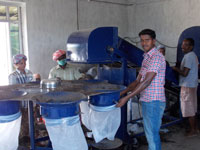 The best approach would be to apply mushroom compost uniformly and evenly at a one to three inch thickness (three to nine cubic yards per 1,000 square feet) on the surface of the intended site, and then incorporate into the existing soil below. Next, seed or transplant the desired vegetation. For example, with turfgrass, sow the grass seed uniformly at a rate recommended for the turfgrass species used, and water thoroughly. For sites with steep slopes, erosion blankets or netting may be helpful to reduce further the possibility of soil erosion.
The best approach would be to apply mushroom compost uniformly and evenly at a one to three inch thickness (three to nine cubic yards per 1,000 square feet) on the surface of the intended site, and then incorporate into the existing soil below. Next, seed or transplant the desired vegetation. For example, with turfgrass, sow the grass seed uniformly at a rate recommended for the turfgrass species used, and water thoroughly. For sites with steep slopes, erosion blankets or netting may be helpful to reduce further the possibility of soil erosion.
What about salts?
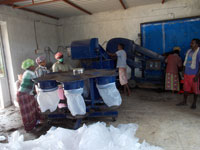 Excessive amounts of soluble salts (for example, calcium, magnesium, potassium and others) in the soil can cause injury to turfgrasses and other groundcover-type plants. However, research at Penn State shows that good quality mushroom compost does not contain soluble salt concentrations high enough to impede turfgrass seed germination or cause damage to an existing turf stand. Also, when mushroom compost is tilled or incorporated into the soil, the salt concentration is diluted greatly, and irrigation or natural rainfall will further reduce salt concentrations by leaching those salts from the root zone. Ask your mushroom compost supplier to provide you with a detailed laboratory analysis to ensure you’re getting good quality and a reliable compost product.
Excessive amounts of soluble salts (for example, calcium, magnesium, potassium and others) in the soil can cause injury to turfgrasses and other groundcover-type plants. However, research at Penn State shows that good quality mushroom compost does not contain soluble salt concentrations high enough to impede turfgrass seed germination or cause damage to an existing turf stand. Also, when mushroom compost is tilled or incorporated into the soil, the salt concentration is diluted greatly, and irrigation or natural rainfall will further reduce salt concentrations by leaching those salts from the root zone. Ask your mushroom compost supplier to provide you with a detailed laboratory analysis to ensure you’re getting good quality and a reliable compost product.
What about weeds?
Prior to removing the compost from a mushroom production house, the entire inside of the house is steam-treated (i.e., pasteurized) to eliminate any pests, pathogens or weed seeds. In the past, lawn and garden centers often advertised “mushroom soil,” which essentially had been sitting outside in a pile for one or two years and had accumulated air-borne weed seeds (such as lambsquaters and velvetleaf). Then, when this compost was tilled into a garden, those weed seeds would emerge with a vengeance. Again, insist on a uniform and quality mushroom compost that has been pasteurized, processed, and properly stored to ensure no contamination from weed seeds. Characteristics of SMS Spent mushroom substrate is the composted organic material remaining after a crop of mushrooms is harvested. Mushrooms are grown in a mixture of natural products, including horse-bedded straw (straw from horse stables), hay, poultry manure, ground corn cobs, cottonseed hulls, gypsum, and other substances. This mixture is composted in piles or ricks, creating a dark brown, fibrous, and pliable organic growing media. When the composting process is complete, the media is brought into mushroom houses where it is placed into beds or trays and used as a substrate for growing mushrooms. After the mushrooms are harvested, the "spent" substrate is removed from the houses and pasteurized with steam to kill insects, pathogens, and mushroom remnants.
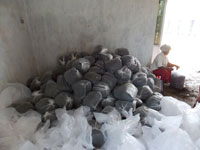 Spent mushroom substrate is sometimes sold immediately after it is removed from mushroom houses; in this case it is referred to as "fresh SMS". Alternatively, the SMS can be placed in windrows and further composted for several weeks or several months. This material is often called "weathered SMS" and differs in composition and appearance from fresh SMS. Some producers blend SMS with soil to produce a ready-to-use growing medium for turfgrasses and other plants.
Spent mushroom substrate is sometimes sold immediately after it is removed from mushroom houses; in this case it is referred to as "fresh SMS". Alternatively, the SMS can be placed in windrows and further composted for several weeks or several months. This material is often called "weathered SMS" and differs in composition and appearance from fresh SMS. Some producers blend SMS with soil to produce a ready-to-use growing medium for turfgrasses and other plants.
Selecting a SMS product - some guidelines to follow
Although many of the ingredients that go into SMS products are similar, not all products are alike. Quality of SMS can vary depending on the ingredients, how it is produced, and how it is treated after it comes out of the mushroom production houses. Because of potential quality differences among products, it is important to have some basis for determining suitability for use on turf. Ideally, the product you intend to use has been field tested and used successfully by other turf managers. Using a SMS product with a proven track record can take some of the guess work out of the selection process provided that it is consistent from batch to batch.
Whether you are using a field-tested SMS or one that has never been used on turf, be sure to obtain a sample of the product prior to use and examine it for undesirable objects and peculiar or offensive odors. If the producer does not have an analysis of chemical and physical properties, submit a representative sample to a laboratory that will conduct appropriate tests and provide recommendations that you can understand. Penn State's Agricultural Analytical Services Laboratory offers a compost testing service with several options for analysis of SMS products.
Some basic guidelines for evaluating the suitability of SMS products for use on term follows.
General appearance: The appearance of fresh SMS is similar to peat, with a light brown color and a light, fibrous texture. Weathered SMS products should resemble dark topsoil and have a loose, crumbly structure. All SMS products to be used on turf should be free of large stones, plastic, and other objectionable objects.
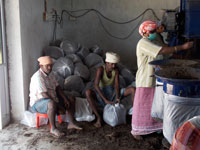 Particle size: The size of SMS particles can vary depending on how it is produced. For use in surface applications on athletic fields, lawns, or golf course fairways, the SMS should pass through a 1/2 inch screen (or be of similar size). Composts with slightly larger particles can be used as soil amendments if thoroughly tilled into the soil prior to seeding or sodding.
Particle size: The size of SMS particles can vary depending on how it is produced. For use in surface applications on athletic fields, lawns, or golf course fairways, the SMS should pass through a 1/2 inch screen (or be of similar size). Composts with slightly larger particles can be used as soil amendments if thoroughly tilled into the soil prior to seeding or sodding.
Odor: A good quality SMS product should have an 'earthy' aroma. It should not emit peculiar or offensive odors such as those associated sulfur or rotten eggs. Also, it should not emit a strong ammonia odor. Peculiar odors may be an indication that the product is not mature (not fully composted). Immature SMS may have adverse effects on turf and should not be used.
Weed seeds: If the SMS product has been properly composted and stored, weed seed contamination will not be a problem. On rare occasions, SMS products are stored for long periods and neglected. In such cases, weed plants can begin to grow in the piles. If these weeds are not controlled immediately they can deposit seeds in the product.
Although a few weed seeds do not necessarily preclude the use of a SMS product as a soil amendment for turf, products containing large amounts of weed seeds are unacceptable. If possible, inspect the production site to make sure that weeds are not growing in and around the SMS piles.
Moisture content: The moisture content of a SMS product is important where uniform application and good mixing with soil is desired. Products with moisture contents between 30 and 50% are usually ideal for handling, surface applications, and soil incorporation. Wet products (greater than 60% moisture content) tend to form clumps and do not spread evenly when applied to turf surfaces. Tilling wet material into soil may result in poor mixing with soil and uneven turf establishment. Wet SMS is heavy and difficult to handle.
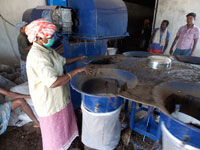 A quick field test that you can use to determine suitable water content of SMS is to squeeze the product in the palm of your hand and watch for water oozing from the product. If water drips from the SMS upon squeezing, then the product may be too wet, and further drying should improve product handling. If the SMS remains together when you release your grip and no water drips from the product, it probably has suitable water content for spreading and mixing with soil.
A quick field test that you can use to determine suitable water content of SMS is to squeeze the product in the palm of your hand and watch for water oozing from the product. If water drips from the SMS upon squeezing, then the product may be too wet, and further drying should improve product handling. If the SMS remains together when you release your grip and no water drips from the product, it probably has suitable water content for spreading and mixing with soil.
Organic matter and ash content: When using SMS as an organic matter supplement, keep in mind that not all of the product is organic matter. Spent mushroom substrate products typically contain between 40 and 60% organic matter on a dry weight basis. Organic matter content can be determined by a lab test. The most common procedure employed by laboratories, "loss on ignition", considers everything that is combustible as organic matter.
Some test labs report a value called 'ash content'. Ash is the mineral matter that remains after the SMS sample has been subjected to extremely high temperatures in a furnace. Assuming that everything burned-off in the furnace is organic matter, the percentage of ash in the sample can be subtracted from 100 to provide an estimate of percent organic matter. For example, an ash content of 40% indicates that there is an estimated 60% organic matter in the sample.
Carbon to nitrogen ratio: The amount of carbon (C) relative to the amount of nitrogen (N) in a SMS product is an important indicator of nitrogen availability. The carbon to nitrogen (C:N) ratio of a product should be 30:1 or below. If above 35:1, soil microorganisms can immobilize nitrogen, making it unavailable to the turf. Most SMS products have C:N ratios well below 30:1.
Nutrients: When compared with fertilizers, SMS products generally contain low amounts of plant nutrients. Whereas a small amount of quick-release nitrogen (ammonium) is present in SMS, most nitrogen is in the organic form and is slowly available to turf. Test results of SMS products typically indicate 1.5 to 3% total nitrogen on a dry weight basis. Other nutrients found in SMS include phosphorus (0.5 to 2.0 %, reported as P 2 O 5 ), potassium (1.0 to 3.0%, reported as K 2 O), calcium (3 to 6%), and magnesium (0.4 to 1.0%).
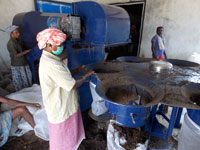 Typically, significant amounts of SMS must be applied to supply all or most of the turf's nutrient requirements. In some cases, this can be achieved for short durations (8 to 10 weeks) with surface applications of ¼ to ½ inch of SMS, aerated into the soil surface. In many cases, a 1 or 2 inch layer of SMS tilled 4 to 6 inches into soil can supply all of the nutrients necessary for turf growth and development for an entire year and possibly longer.
Typically, significant amounts of SMS must be applied to supply all or most of the turf's nutrient requirements. In some cases, this can be achieved for short durations (8 to 10 weeks) with surface applications of ¼ to ½ inch of SMS, aerated into the soil surface. In many cases, a 1 or 2 inch layer of SMS tilled 4 to 6 inches into soil can supply all of the nutrients necessary for turf growth and development for an entire year and possibly longer.
pH: The pH of most SMS products is between 6.0 and 8.0, a range favorable for turf root growth. On rare occasion, a product may fall outside of this range. The pH of organic amendments may be detrimental to turf when very high (greater than 8.5) or very low (less than 5.5). Extremes in pH may result in reduced availability of some plant nutrients and/or aluminum toxicity problems. Fortunately, most soils are buffered against rapid and drastic changes in pH and even organic amendments with extremes in pH may not alter the overall soil pH a great deal. To be on the safe side, however, try using products with a pH between 6.0 and 8.0.
Soluble salts: Soluble salts may be higher in SMS products than in other types of organic amendments. Whereas, excess soluble salts can cause turf injury, research conducted at Penn State shows that good quality SMS products do not contain salt levels high enough to damage turf. If you have questions regarding the soluble salt content of a particular SMS product and how safe it is to use on turf, send the product to a soil test lab that performs soluble salts analyses on composts.